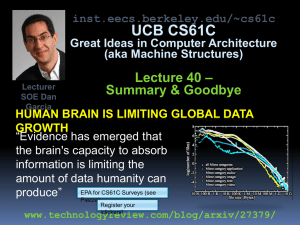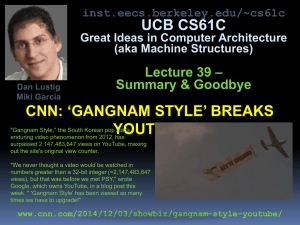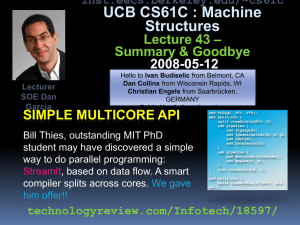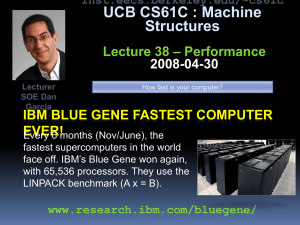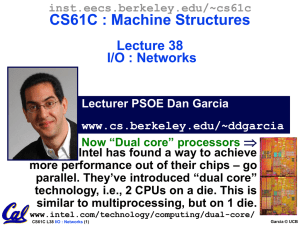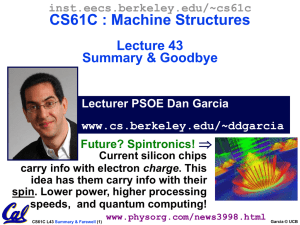2010SpCS61C-L38-ddg-..
advertisement
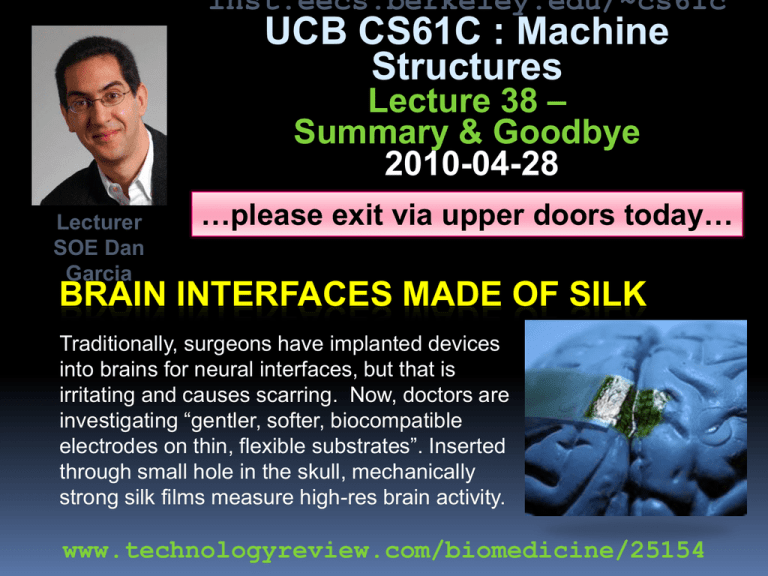
inst.eecs.berkeley.edu/~cs61c
UCB CS61C : Machine
Structures
Lecture 38 –
Summary & Goodbye
2010-04-28
Lecturer
SOE Dan
Garcia
…please exit via upper doors today…
BRAIN INTERFACES MADE OF SILK
Traditionally, surgeons have implanted devices
into brains for neural interfaces, but that is
irritating and causes scarring. Now, doctors are
investigating “gentler, softer, biocompatible
electrodes on thin, flexible substrates”. Inserted
through small hole in the skull, mechanically
strong silk films measure high-res brain activity.
www.technologyreview.com/biomedicine/25154
Cool Stuff…the videos before lecture
SIGGRAPH Electronic Theatre
www.siggraph.org/publications/video-review
$40/video for ACM Members
SIGGRAPH Conference in Los Angeles!
2010-07-25 2010-07-29
www.siggraph.org/s2010/
CS61C L38 Summary & Goodbye (2)
Garcia, Spring 2010 © UCB
Review : Parallelism
Above the line (inter-computer, many machines)
& below the line (intra-computer, multiple cores
& CPUs) both critical for future.
Hard to write code that fully takes advantage of all
available resources to get optimal speedup.
Amdahl’s Law: MaxSpeedup = 1/s (s = % of serial code)
Inter-computing ||ism : Distributed & Supercomputing
Grid (usu remote, heterogeneous) & Cluster computing
Synchronization hard, APIs help (MapReduce, MPI)
Intra-computing ||ism : pthreads, OpenMP
Cache coherence makes it difficult! Manycore, not multicore!
Berkeley EECS & PAR lab on cutting edge!!
CS61C L38 Summary & Goodbye (3)
Garcia, Spring 2010 © UCB
We learned about “Machine Structures”
Application (ex: browser)
Compiler
Software
Hardware
Assembler
Operating
System
(Mac OSX)
Processor Memory I/O system
CS61C
Instruction Set
Architecture
Datapath & Control
Digital Design
Circuit Design
transistors
Coordination of many levels (layers) of
abstraction
CS61C L38 Summary & Goodbye (4)
Garcia, Spring 2010 © UCB
We made HW/SW contact!
High Level Language
Program (e.g., C)
Compiler
Assembly Language
Program (e.g.,MIPS)
Assembler
Machine Language
Program (MIPS)
temp = v[k];
v[k] = v[k+1];
v[k+1] = temp;
lw
lw
sw
sw
0000
1010
1100
0101
$t0, 0($2)
$t1, 4($2)
$t1, 0($2)
$t0, 4($2)
1001
1111
0110
1000
1100
0101
1010
0000
0110
1000
1111
1001
1010
0000
0101
1100
1111
1001
1000
0110
0101
1100
0000
1010
1000
0110
1001
1111
Machine
Interpretation
Hardware Architecture Description
(e.g., block diagrams)
Architecture
Implementation
Logic Circuit Description
(Circuit Schematic Diagrams)
CS61C L38 Summary & Goodbye (5)
Garcia, Spring 2010 © UCB
CS61C: So what did you learn? (1st
lecture)
Learn some of the big ideas in CS & Engineering:
5 classic components of a Computer
Principle of abstraction, systems built as layers
Data can be anything (integers, floating point,
characters): a program determines what it is
Stored program concept: instructions just data
Compilation v. interpretation thru system layers
Principle of Locality, exploited via memory hierarchy
(caches)
Benefits of a layer of indirection (VM)
Greater performance by exploiting parallelism
Pipelining, superscaler, MPI, MapReduce, OpenMP, pthreads
Principles/Pitfalls of Performance Measurement
CS61C L38 Summary & Goodbye (6)
Garcia, Spring 2010 © UCB
Life: So what did you learn? (all yr)
Use ISO 8601
YYYY-MM-DD
Don’t be afraid
…to ask questions, sit in front, dance in the aisles
Find your partner
Find the Yin to your Yang (project & life partners)
Enjoy your youth
E.g., Travel while you aren’t tied down in your life
Love your job
Love what you do; do what you love
CS61C L38 Summary & Goodbye (7)
Garcia, Spring 2010 © UCB
20th vs. 21st Century IT Targets
20th Century Measure of Success
Performance (peak vs. delivered)
Cost (purchase cost vs. ownership cost, power)
21st Century Measure of Success? “SPUR”
Security
Privacy
Usability
Reliability
Massive parallelism greater chance (this time) if
Measure of success is SPUR vs. only cost-perf
Uniprocessor performance improvement decelerates
CS61C L38 Summary & Goodbye (8)
Garcia, Spring 2010 © UCB
Other Implications
Need to revisit chronic unsolved problem
Parallel programming!!
Implications for applications:
Computing power >>> CDC6600, Cray XMP
(choose your favorite supercomputer) on an
economical die inside your watch, cell phone or
PDA
On your body health monitoring
Google + library of congress on your PDA
As devices continue to shrink…
The need for great HCI (human-computer
interfaces) is as critical as ever!
CS61C L38 Summary & Goodbye (9)
Garcia, Spring 2010 © UCB
Upcoming Calendar
Week #
#14
Last week
o’ classes
Mon
Wed
Thu Lab
Intermachine
Parallelism
Summary,
Review,
Evaluation
Parallel
#15
RRR Week
Fri
Intramachine
Parallelism(
Scott)
P3 due
Perf comp
due 11:59pm
#16
Finals Week
Review Sun
May 9 3-6pm
10 Evans
CS61C L38 Summary & Goodbye (10)
Final Exam
8-11am in
230 Hearst
Gym
Garcia, Spring 2010 © UCB
Administrivia: Become active!
Final Exam details
Only bring pen{,cil}s, two 8.5”x11” handwritten sheets
(writing on both sides) + green sheet.
Leave backpacks, books, calculators, cells & pagers home!
Everyone must take ALL of the final!
If you did well in CS3 or 61[ABC]
(A- or above) and want to be on staff?
Usual path: Lab Assistant
Reader TA
LA: sign up w/Jenny Jones in 395 Soda before 1st week of
semester
Reader/TA forms: www.cs/~juliea/
I strongly encourage anyone who gets an A- or above in the
class to follow this path…
CS61C L38 Summary & Goodbye (11)
Garcia, Spring 2010 © UCB
Taking advantage of Cal
Opportunities
“The Godfather answers all of life’s questions”
– Heard in “You’ve got Mail”
Why were we the #2 Univ in the WORLD?
So says the 2004 ranking from the “Times Higher Education Supplement”
Research, reseach, research!
Whether you want to go to grad school or
industry, you need someone to vouch for you!
…as is the case with the Mob
Techniques
Find out what you like, do lots of web research
(read published papers), hit OH of Prof, show
enthusiasm & initiative
http://research.berkeley.edu/
CS61C L38 Summary & Goodbye (12)
Garcia, Spring 2010 © UCB
Dan’s Opportunities Fall 2010
GamesCrafters (Game Theory R & D)
Develop SW, analysis on 2-person games of no
chance. (e.g., go, chess, connect-4, nim, etc.)
Req: ≥ A- in CS61C, Game Theory / SW Interest
MS-DOS X (Mac Student Developers)
Learn to program Macintoshes.
Req: Interest. Owning a mac helps, not required.
Taught as a DeCal by MS-DOS X veterans
UCBUGG (Recreational Graphics)
Develop computer-generated images, animations.
Req: 3D interest
Taught as a DeCal by UCBUGG veterans
CNM190/CS194-8 (Advanced Digital Animation)
Learn how the experts make 3D computer animations
Req: 3D Experience; we’ll choose students by
experience
This
is a& Goodbye
ONE-YEAR
course… (Fall 2010 + Spring
Garcia, Spring 2010 © UCB
CS61C
L38 Summary
(13)
Anatomy: 5 components of any Computer
In the future, what’ll
be the most
important
computer
component?
Computer
Devices
Processor
Control
(“brain”)
a)
b)
c)
d)
e)
Control
Datapath
Memory
Input
Output
CS61C L38 Summary & Goodbye (14)
Datapath
(“brawn”)
Memory
Input
Output
Garcia, Spring 2010 © UCB
Peer Instruction Opinion
“Forget cloning. Forget TVs on
your wrist watch. The biggest
invention of the next 100 years
will be the ability to directly connect your brain
to a machine, aka wet computing.” – Dan Garcia
A macaque monkey at Duke University can already
control a robotic arm with thought.
DARPA interested for mind-control robots & flying
Virtual Reality achieved with proper I/O interfacing…
Jose Carmena, UCB EECS Prof
Research: Brain-Machine Interface
www.eecs.berkeley.edu/~carmena/
CS61C L38 Summary & Goodbye (15)
Garcia, Spring 2010 © UCB
Penultimate slide: Thanks to the staff!
TAs
Head TA Scott
Beamer
Eric Chang
Michael Greenbaum
Long Wei
Bing Xia
Readers
Anurag Jain
Rohit Poddar
Ibrahim Awwal
Myo Nyi Nyi
Andy Horng
Thanks to all the former CS61C instructors
who have added to these notes…
The Future for Future Cal Alumni
What’s The Future?
New Millennium
Ubiquitous & Quantum Computing,
Nanotechnology, 10 M “volunteer” CPUs, the
Parallel revolution...
Please exit
Rapid Changes in Technology
via upper
World’s Best Education
doors…
Never Give Up!
2nd
“The best way to predict the future is to invent it”
– Alan Kay
The Future is up to you!
CS61C L38 Summary & Goodbye (17)
Garcia, Spring 2010 © UCB
